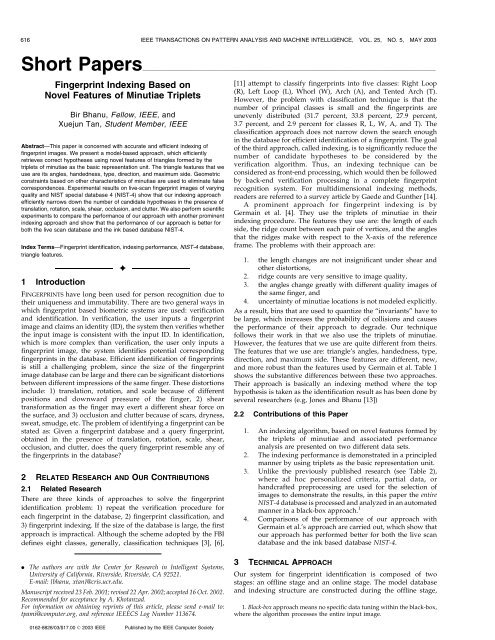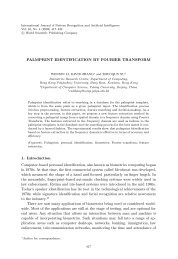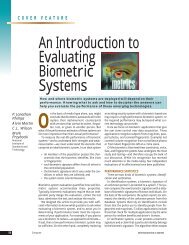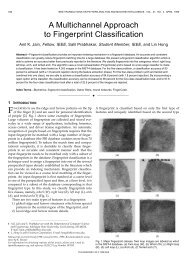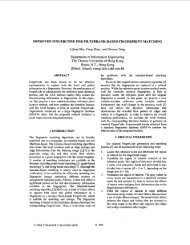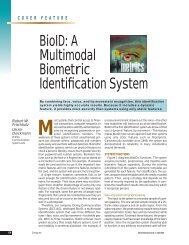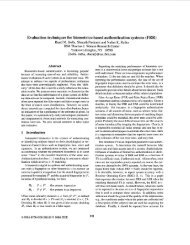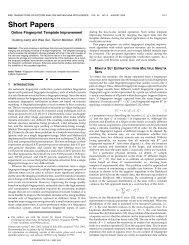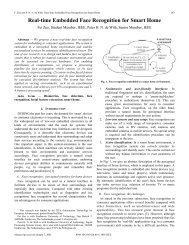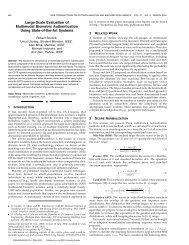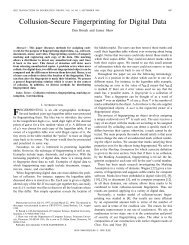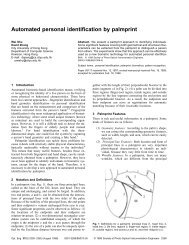Fingerprint indexing based on novel features of minutiae triplets ...
Fingerprint indexing based on novel features of minutiae triplets ...
Fingerprint indexing based on novel features of minutiae triplets ...
You also want an ePaper? Increase the reach of your titles
YUMPU automatically turns print PDFs into web optimized ePapers that Google loves.
616 IEEE TRANSACTIONS ON PATTERN ANALYSIS AND MACHINE INTELLIGENCE, VOL. 25, NO. 5, MAY 2003Short Papers___________________________________________________________________________________________________<str<strong>on</strong>g>Fingerprint</str<strong>on</strong>g> Indexing Based <strong>on</strong>Novel Features <strong>of</strong> Minutiae TripletsBir Bhanu, Fellow, IEEE, andXuejun Tan, Student Member, IEEEAbstract—This paper is c<strong>on</strong>cerned with accurate and efficient <str<strong>on</strong>g>indexing</str<strong>on</strong>g> <strong>of</strong>fingerprint images. We present a model-<str<strong>on</strong>g>based</str<strong>on</strong>g> approach, which efficientlyretrieves correct hypotheses using <strong>novel</strong> <strong>features</strong> <strong>of</strong> triangles formed by the<strong>triplets</strong> <strong>of</strong> <strong>minutiae</strong> as the basic representati<strong>on</strong> unit. The triangle <strong>features</strong> that weuse are its angles, handedness, type, directi<strong>on</strong>, and maximum side. Geometricc<strong>on</strong>straints <str<strong>on</strong>g>based</str<strong>on</strong>g> <strong>on</strong> other characteristics <strong>of</strong> <strong>minutiae</strong> are used to eliminate falsecorresp<strong>on</strong>dences. Experimental results <strong>on</strong> live-scan fingerprint images <strong>of</strong> varyingquality and NIST special database 4 (NIST-4) show that our <str<strong>on</strong>g>indexing</str<strong>on</strong>g> approachefficiently narrows down the number <strong>of</strong> candidate hypotheses in the presence <strong>of</strong>translati<strong>on</strong>, rotati<strong>on</strong>, scale, shear, occlusi<strong>on</strong>, and clutter. We also perform scientificexperiments to compare the performance <strong>of</strong> our approach with another prominent<str<strong>on</strong>g>indexing</str<strong>on</strong>g> approach and show that the performance <strong>of</strong> our approach is better forboth the live scan database and the ink <str<strong>on</strong>g>based</str<strong>on</strong>g> database NIST-4.Index Terms—<str<strong>on</strong>g>Fingerprint</str<strong>on</strong>g> identificati<strong>on</strong>, <str<strong>on</strong>g>indexing</str<strong>on</strong>g> performance, NIST-4 database,triangle <strong>features</strong>.1 Introducti<strong>on</strong>æFINGERPRINTS have l<strong>on</strong>g been used for pers<strong>on</strong> recogniti<strong>on</strong> due totheir uniqueness and immutability. There are two general ways inwhich fingerprint <str<strong>on</strong>g>based</str<strong>on</strong>g> biometric systems are used: verificati<strong>on</strong>and identificati<strong>on</strong>. In verificati<strong>on</strong>, the user inputs a fingerprintimage and claims an identity (ID), the system then verifies whetherthe input image is c<strong>on</strong>sistent with the input ID. In identificati<strong>on</strong>,which is more complex than verificati<strong>on</strong>, the user <strong>on</strong>ly inputs afingerprint image, the system identifies potential corresp<strong>on</strong>dingfingerprints in the database. Efficient identificati<strong>on</strong> <strong>of</strong> fingerprintsis still a challenging problem, since the size <strong>of</strong> the fingerprintimage database can be large and there can be significant distorti<strong>on</strong>sbetween different impressi<strong>on</strong>s <strong>of</strong> the same finger. These distorti<strong>on</strong>sinclude: 1) translati<strong>on</strong>, rotati<strong>on</strong>, and scale because <strong>of</strong> differentpositi<strong>on</strong>s and downward pressure <strong>of</strong> the finger, 2) sheartransformati<strong>on</strong> as the finger may exert a different shear force <strong>on</strong>the surface, and 3) occlusi<strong>on</strong> and clutter because <strong>of</strong> scars, dryness,sweat, smudge, etc. The problem <strong>of</strong> identifying a fingerprint can bestated as: Given a fingerprint database and a query fingerprint,obtained in the presence <strong>of</strong> translati<strong>on</strong>, rotati<strong>on</strong>, scale, shear,occlusi<strong>on</strong>, and clutter, does the query fingerprint resemble any <strong>of</strong>the fingerprints in the database?2 RELATED RESEARCH AND OUR CONTRIBUTIONS2.1 Related ResearchThere are three kinds <strong>of</strong> approaches to solve the fingerprintidentificati<strong>on</strong> problem: 1) repeat the verificati<strong>on</strong> procedure foreach fingerprint in the database, 2) fingerprint classificati<strong>on</strong>, and3) fingerprint <str<strong>on</strong>g>indexing</str<strong>on</strong>g>. If the size <strong>of</strong> the database is large, the firstapproach is impractical. Although the scheme adopted by the FBIdefines eight classes, generally, classificati<strong>on</strong> techniques [3], [6],[11] attempt to classify fingerprints into five classes: Right Loop(R), Left Loop (L), Whorl (W), Arch (A), and Tented Arch (T).However, the problem with classificati<strong>on</strong> technique is that thenumber <strong>of</strong> principal classes is small and the fingerprints areunevenly distributed (31.7 percent, 33.8 percent, 27.9 percent,3.7 percent, and 2.9 percent for classes R, L, W, A, and T). Theclassificati<strong>on</strong> approach does not narrow down the search enoughin the database for efficient identificati<strong>on</strong> <strong>of</strong> a fingerprint. The goal<strong>of</strong> the third approach, called <str<strong>on</strong>g>indexing</str<strong>on</strong>g>, is to significantly reduce thenumber <strong>of</strong> candidate hypotheses to be c<strong>on</strong>sidered by theverificati<strong>on</strong> algorithm. Thus, an <str<strong>on</strong>g>indexing</str<strong>on</strong>g> technique can bec<strong>on</strong>sidered as fr<strong>on</strong>t-end processing, which would then be followedby back-end verificati<strong>on</strong> processing in a complete fingerprintrecogniti<strong>on</strong> system. For multidimensi<strong>on</strong>al <str<strong>on</strong>g>indexing</str<strong>on</strong>g> methods,readers are referred to a survey article by Gaede and Gunther [14].A prominent approach for fingerprint <str<strong>on</strong>g>indexing</str<strong>on</strong>g> is byGermain et al. [4]. They use the <strong>triplets</strong> <strong>of</strong> <strong>minutiae</strong> in their<str<strong>on</strong>g>indexing</str<strong>on</strong>g> procedure. The <strong>features</strong> they use are: the length <strong>of</strong> eachside, the ridge count between each pair <strong>of</strong> vertices, and the anglesthat the ridges make with respect to the X-axis <strong>of</strong> the referenceframe. The problems with their approach are:1. the length changes are not insignificant under shear andother distorti<strong>on</strong>s,2. ridge counts are very sensitive to image quality,3. the angles change greatly with different quality images <strong>of</strong>the same finger, and4. uncertainty <strong>of</strong> <strong>minutiae</strong> locati<strong>on</strong>s is not modeled explicitly.As a result, bins that are used to quantize the “invariants” have tobe large, which increases the probability <strong>of</strong> collisi<strong>on</strong>s and causesthe performance <strong>of</strong> their approach to degrade. Our techniquefollows their work in that we also use the <strong>triplets</strong> <strong>of</strong> <strong>minutiae</strong>.However, the <strong>features</strong> that we use are quite different from theirs.The <strong>features</strong> that we use are: triangle’s angles, handedness, type,directi<strong>on</strong>, and maximum side. These <strong>features</strong> are different, new,and more robust than the <strong>features</strong> used by Germain et al. Table 1shows the substantive differences between these two approaches.Their approach is basically an <str<strong>on</strong>g>indexing</str<strong>on</strong>g> method where the tophypothesis is taken as the identificati<strong>on</strong> result as has been d<strong>on</strong>e byseveral researchers (e.g, J<strong>on</strong>es and Bhanu [13])2.2 C<strong>on</strong>tributi<strong>on</strong>s <strong>of</strong> this Paper1. An <str<strong>on</strong>g>indexing</str<strong>on</strong>g> algorithm, <str<strong>on</strong>g>based</str<strong>on</strong>g> <strong>on</strong> <strong>novel</strong> <strong>features</strong> formed bythe <strong>triplets</strong> <strong>of</strong> <strong>minutiae</strong> and associated performanceanalysis are presented <strong>on</strong> two different data sets.2. The <str<strong>on</strong>g>indexing</str<strong>on</strong>g> performance is dem<strong>on</strong>strated in a principledmanner by using <strong>triplets</strong> as the basic representati<strong>on</strong> unit.3. Unlike the previously published research (see Table 2),where ad hoc pers<strong>on</strong>alized criteria, partial data, orhandcrafted preprocessing are used for the selecti<strong>on</strong> <strong>of</strong>images to dem<strong>on</strong>strate the results, in this paper the entireNIST-4 database is processed and analyzed in an automatedmanner in a black-box approach. 14. Comparis<strong>on</strong>s <strong>of</strong> the performance <strong>of</strong> our approach withGermain et al.’s approach are carried out, which show thatour approach has performed better for both the live scandatabase and the ink <str<strong>on</strong>g>based</str<strong>on</strong>g> database NIST-4.. The authors are with the Center for Research in Intelligent Systems,University <strong>of</strong> California, Riverside, Riverside, CA 92521.E-mail: {bhanu, xtan}@cris.ucr.edu.Manuscript received 23 Feb. 2001; revised 22 Apr. 2002; accepted 16 Oct. 2002.Recommended for acceptance by A. Khotanzad.For informati<strong>on</strong> <strong>on</strong> obtaining reprints <strong>of</strong> this article, please send e-mail to:tpami@computer.org, and reference IEEECS Log Number 113674.3 TECHNICAL APPROACHOur system for fingerprint identificati<strong>on</strong> is composed <strong>of</strong> twostages: an <strong>of</strong>fline stage and an <strong>on</strong>line stage. The model databaseand <str<strong>on</strong>g>indexing</str<strong>on</strong>g> structure are c<strong>on</strong>structed during the <strong>of</strong>fline stage,1. Black-box approach means no specific data tuning within the black-box,where the algorithm processes the entire input image.0162-8828/03/$17.00 ß 2003 IEEE Published by the IEEE Computer Society
IEEE TRANSACTIONS ON PATTERN ANALYSIS AND MACHINE INTELLIGENCE, VOL. 25, NO. 5, MAY 2003 617TABLE 1Comparis<strong>on</strong> between Germain et al.’s [4] Approach and Bhanu and Tan’s ApproachesTABLE 2NIST-4 Database Used in <str<strong>on</strong>g>Fingerprint</str<strong>on</strong>g> Recogniti<strong>on</strong> Research Publishedand identificati<strong>on</strong> is carried out during the <strong>on</strong>line stage. During the<strong>of</strong>fline stage, fingerprints in the database are processed <strong>on</strong>e-by-<strong>on</strong>eto extract <strong>minutiae</strong> [1] to c<strong>on</strong>struct model database. During the<strong>on</strong>line stage, the query image is processed by the same procedureto extract <strong>minutiae</strong>. Indexing comp<strong>on</strong>ents are derived from the<strong>triplets</strong> <strong>of</strong> <strong>minutiae</strong> locati<strong>on</strong>s and used to map the points in thefeature space to the points in the <str<strong>on</strong>g>indexing</str<strong>on</strong>g> space. The potentialcorresp<strong>on</strong>dences between the query image and images in thedatabase are searched in a local area in the <str<strong>on</strong>g>indexing</str<strong>on</strong>g> space. An<str<strong>on</strong>g>indexing</str<strong>on</strong>g> score is computed <str<strong>on</strong>g>based</str<strong>on</strong>g> <strong>on</strong> the number <strong>of</strong> trianglecorresp<strong>on</strong>dences and candidate hypotheses are generated. The topN ranked hypotheses are the result <strong>of</strong> our <str<strong>on</strong>g>indexing</str<strong>on</strong>g> algorithm.3.1 Analysis <strong>of</strong> Angle Changes Under Distorti<strong>on</strong>sWithout loss <strong>of</strong> generality, we assume that <strong>on</strong>e vertex, O, <strong>of</strong> thetriangle (see Fig. 1) is ð0; 0Þ, and it does not change under distorti<strong>on</strong>s.Since distance is invariant under translati<strong>on</strong> and rotati<strong>on</strong> andrelatively invariant under scale, and angles are defined in terms <strong>of</strong>the ratio <strong>of</strong> distance, it can be proven that angles are invariant underthese transformati<strong>on</strong>s. However, because <strong>of</strong> uncertainty <strong>of</strong> <strong>minutiae</strong>locati<strong>on</strong>s, the locati<strong>on</strong> <strong>of</strong> each vertex changes independently in asmall local area in a random manner. Suppose the locati<strong>on</strong>s <strong>of</strong> pointsA and B are ðx 1 ; 0Þ and ðx 2 ;y 2 Þ, x 1 > 0, y 2 > 0, and x 2 2 ð1; þ1Þ.We have tan ¼ y 2 =ðx 1 x 2 Þ. Because <strong>of</strong> the uncertainty <strong>of</strong><strong>minutiae</strong> locati<strong>on</strong>s, A and B move to A 0 ðx 1 þ x 1 ; 0Þ and B 0 ðx 2 þx 2 ;y 2 þ y 2 Þ; respectively, and changes to þ ; thentan ¼ððx 1 x 2 Þy 2 y 2 ðx 1 x 2 ÞÞ=ððx 1 x 2 Þ 2 þðx 1 x 2 Þðx 1 x 2 Þþy 2 2 þ y 2y 2 Þ:Suppose j x 1 x 2 j
618 IEEE TRANSACTIONS ON PATTERN ANALYSIS AND MACHINE INTELLIGENCE, VOL. 25, NO. 5, MAY 2003TABLE 3Expectati<strong>on</strong> <strong>of</strong> the Percentage <strong>of</strong> Angle Changes Less than Various ThresholdsThat is, if the changes <strong>of</strong> <strong>minutiae</strong> locati<strong>on</strong>s are small enough, thechange <strong>of</strong> the angle will be less than a certain small value.Furthermore, we can compute the expectati<strong>on</strong> <strong>of</strong> j j . Letfðx 1 ;x 2 ;y 2 ; x 1 ; x 2 ; y 2 Þ¼tan. Suppose x 1 , x 2 , and y 2are independent, and 4 x i 4, 4 y 2 4, i ¼ 1; 2, andx i and y 2 are all integers, we havegðx 1 ;x 2 ;y 2 ÞX4X 4X 4x 1¼4 x 2¼4 x 3¼4ðj fðx 1 ;x 2 ;y 2 ; x 1 ; x 2 ; y 2 Þpðx 1 Þpðx 2 Þpðy 2 Þj:Assuming pðx 1 Þ, pðx 2 Þ and pðy 2 Þ are all discrete uniformdistributi<strong>on</strong>s in ½4; þ4Š. Let 0
620 IEEE TRANSACTIONS ON PATTERN ANALYSIS AND MACHINE INTELLIGENCE, VOL. 25, NO. 5, MAY 2003Fig. 5. Sample images: (a) data set 1 and (b) data set 2.Fig. 8. ROC justifies T ¼ 20.Fig. 6. CIP <strong>of</strong> data set 1.(47.8 percent). The data set 2 is the NIST special database 4 (NIST-4)[9] that c<strong>on</strong>tains 2,000 pairs <strong>of</strong> images. Since these images arecollected with an ink <str<strong>on</strong>g>based</str<strong>on</strong>g> method, a large number <strong>of</strong> NIST-4images are <strong>of</strong> much poorer quality. NIST-4 images <strong>of</strong>ten c<strong>on</strong>tainother objects, such as characters and handwritten lines (see Fig. 5b).The size <strong>of</strong> these images is 480 512 pixels with the resoluti<strong>on</strong> <strong>of</strong> 500DPI. Parameters , , and are different for the two data sets: fordata set 1, ¼ 5 o , ¼ 20 pixels, ¼ 10 pixels, for data set 2, ¼ 10 o , ¼ 40 pixels, ¼ 20 pixels. All other parameters are thesame for both data sets: m ¼ 30 o , l ¼ 30 o ; r ¼ 30 o , t ¼ 50 pixels,T 1 ¼ 4 o , T 2 ¼ 4 o , and T ¼ 20.4.2 Performance Evaluati<strong>on</strong> Measures for IndexingFalse Positive Rate (FPR) and False Negative Rate (FNR) are usedto evaluate the performance <strong>of</strong> a verificati<strong>on</strong> algorithm [10].However, the goal <strong>of</strong> the <str<strong>on</strong>g>indexing</str<strong>on</strong>g> method in this paper is t<strong>on</strong>arrow down the number <strong>of</strong> hypotheses which need to bec<strong>on</strong>sidered for subsequent verificati<strong>on</strong>. The output <strong>of</strong> an <str<strong>on</strong>g>indexing</str<strong>on</strong>g>algorithm is the set <strong>of</strong> top N hypotheses. If the corresp<strong>on</strong>dingfingerprint is in the list <strong>of</strong> top N hypotheses, we should take the<str<strong>on</strong>g>indexing</str<strong>on</strong>g> result as a correct result. Hence, FPR and FNR are notsuitable for evaluating the results <strong>of</strong> an <str<strong>on</strong>g>indexing</str<strong>on</strong>g> algorithm. Wedefine Correct Index Power (CIP) and Correct Reject Power (CRP)as the performance evaluati<strong>on</strong> measures for <str<strong>on</strong>g>indexing</str<strong>on</strong>g>: CIP ¼ðN ci =N d Þ100% and CRP ¼ðN cr =N s Þ100%, where N ci is theFig. 9. Number <strong>of</strong> corresp<strong>on</strong>ding triangles <strong>of</strong> the 2,000 query images <strong>of</strong> data set 2.number <strong>of</strong> correctly indexed images, N d is the number <strong>of</strong> images inthe database, N cr is the number <strong>of</strong> correctly rejected images, N s isthe number <strong>of</strong> the query images that d<strong>on</strong>’t have corresp<strong>on</strong>dingimages in database.4.3 Indexing Results for Data Set 1Fig. 6 shows the CIP for each class <strong>of</strong> images and the entiredata set 1 with respect to the length <strong>of</strong> the short list <strong>of</strong> hypotheses.The CIP <strong>of</strong> a single hypothesis for good quality images is96.2 percent. As the quality <strong>of</strong> images become worse, the CIPdecreases to 85.5 percent for fair and 83.3 percent for poor images.The average CIP <strong>of</strong> a single hypothesis for the entire database is86.5 percent. The CIP <strong>of</strong> the top 2 hypotheses is 100.0 percent forgood images, and for fair images and poor quality images, the CIP<strong>of</strong> the top five hypotheses are 99.2 percent and 98.0 percent,respectively. For the entire database <strong>of</strong> 400 images, the CIP <strong>of</strong> thetop nine (2.3 percent <strong>of</strong> database) hypotheses is 100.0 percent. Fig. 7shows that <strong>on</strong> data set 1 the performance <strong>of</strong> our approach is betterthan that <strong>of</strong> Germain et al.’s approach. We also evaluated the<str<strong>on</strong>g>indexing</str<strong>on</strong>g> performance <strong>of</strong> our algorithm for the 200 images, whichare not in the database. Our <str<strong>on</strong>g>indexing</str<strong>on</strong>g> algorithm rejected theseimages ðCRP ¼ 100%Þ. Thus, threshold T <str<strong>on</strong>g>based</str<strong>on</strong>g> <strong>on</strong> the analysis <strong>of</strong>Fig. 7. Comparis<strong>on</strong> <strong>of</strong> two approaches.Fig. 10. Distributi<strong>on</strong> <strong>of</strong> corresp<strong>on</strong>ding triangels am<strong>on</strong>g 2,000 query images <strong>of</strong>data set 2.
IEEE TRANSACTIONS ON PATTERN ANALYSIS AND MACHINE INTELLIGENCE, VOL. 25, NO. 5, MAY 2003 621Fig. 11. CIP performance varies with the number <strong>of</strong> corresp<strong>on</strong>ding triangles (data set 2). (a) T ¼ 1, (b) T ¼ 10, and (c) T ¼ 50.our approach works well. Furthmore, we use the hypothesis,which has the highest <str<strong>on</strong>g>indexing</str<strong>on</strong>g> score, as the result <strong>of</strong> identificati<strong>on</strong>to obtain the Receiver Operating characteristic Curve (ROC) shownin Fig. 8, where P ci is the CIP for the top hypothesis and the FalseAlarm Rate FAR ¼ 100 CRP. When T ¼ 20, the FAR is 0 and asT decreases, FAR will increase.4.4 Indexing Results for Data Set 2Fig. 9 shows the number <strong>of</strong> corresp<strong>on</strong>ding triangles for each queryimage <strong>of</strong> data set 2. Note that 32 images do not have anycorresp<strong>on</strong>ding triangles. That is why CIP can not reach 100 percentas the number <strong>of</strong> hypotheses increases. Fig. 10 shows thedistributi<strong>on</strong> <strong>of</strong> the number <strong>of</strong> corresp<strong>on</strong>ding triangles am<strong>on</strong>gthose 2,000 query images <strong>on</strong> a log scale. Because <strong>of</strong> bad quality, forsome queries the number <strong>of</strong> corresp<strong>on</strong>ding triangles is quite small.Fig. 11 shows how CIP performance varies with the number <strong>of</strong>corresp<strong>on</strong>ding triangles for different threshold T. Approximately10 good <strong>features</strong> lead to good <str<strong>on</strong>g>indexing</str<strong>on</strong>g> results.. Effect <strong>of</strong> c<strong>on</strong>straints and computati<strong>on</strong> time. Fig. 12 showsthe effect <strong>of</strong> geometric c<strong>on</strong>straints in reducing the averagepercentage <strong>of</strong> hypotheses that need to be c<strong>on</strong>sidered for<str<strong>on</strong>g>indexing</str<strong>on</strong>g>. We observe that four geometric c<strong>on</strong>straintsprovide a reducti<strong>on</strong> by a factor <strong>of</strong> 589.487, 6.869, 1.428,and 1.007, sequentially. On a SUN ULTRA2 workstati<strong>on</strong>,without optimizati<strong>on</strong>, average time for correctly <str<strong>on</strong>g>indexing</str<strong>on</strong>g>or correctly rejecting a query is less than <strong>on</strong>e sec<strong>on</strong>d.. Extrapolati<strong>on</strong> <strong>of</strong> <str<strong>on</strong>g>indexing</str<strong>on</strong>g> performance. There exists nogeneral theory in the computer visi<strong>on</strong> and pattern recogniti<strong>on</strong>field to predict the performance <strong>of</strong> model-<str<strong>on</strong>g>based</str<strong>on</strong>g><str<strong>on</strong>g>indexing</str<strong>on</strong>g> and matching algorithms under arbitrary transformati<strong>on</strong>sand arbitrary size <strong>of</strong> databases. Initial attemptshave been made in [2], which takes into c<strong>on</strong>siderati<strong>on</strong> <strong>of</strong>uncertainty in <strong>features</strong>, occlusi<strong>on</strong>, clutter and similarity <strong>of</strong>object models. In the absence <strong>of</strong> a general theory, we performextrapolati<strong>on</strong> <strong>of</strong> the results obtained <strong>on</strong> NIST-4 database toestimate the scalability <strong>of</strong> our approach. Let N, the number <strong>of</strong>hypotheses, be 10 percent <strong>of</strong> M, where M is the size <strong>of</strong> thedatabase, but if N>100, then let N ¼ 100, so that themaximum number <strong>of</strong> hypotheses need to be c<strong>on</strong>sidered is100. Fig. 13 shows the extrapolated performance <strong>of</strong> ourapproach <strong>on</strong> databases <strong>of</strong> different size, which uses a linearregressi<strong>on</strong> model. Fig. 14 shows the extrapolati<strong>on</strong> with largeM.AsM increases, the performance will decrease and the 95percent c<strong>on</strong>fidence interval <strong>of</strong> the performance will increase.However, these results indicate that a CIP <strong>of</strong> 50 percent couldbe achieved with a short list <strong>of</strong> 100 hypotheses, which wouldbe <strong>on</strong>ly 0.33 percent <strong>of</strong> a 30,000-image database, which isreally a good performance. This extrapolati<strong>on</strong> from theresults <strong>of</strong> 2,000 images to 30,000 needs to be taken withcauti<strong>on</strong>. It is dependent <strong>on</strong> the quality <strong>of</strong> input images and, asour analysis shows, NIST-4 is a difficult database.. Comparis<strong>on</strong> <strong>of</strong> approaches. We have d<strong>on</strong>e a directcomparis<strong>on</strong> with Germain et al.’s approach. We implementedGermain et al.’s approach and compared theperformance <strong>of</strong> our <str<strong>on</strong>g>indexing</str<strong>on</strong>g> algorithm with it <strong>on</strong> NIST-4data set 2. Fig. 15 shows the comparis<strong>on</strong>s <strong>of</strong> the twoapproaches <strong>on</strong> four subsets, first 100, 500, 1,000, and2,000 fingerprints, <strong>of</strong> data set 2. Our approach hasperformed better than that <strong>of</strong> Germain et al.’s approach.When the entire data set 2 is used, although the CIP <strong>of</strong>Germain et al.’s approach increases from 53.0 percent to67.0 percent, the CIP <strong>of</strong> our approach increases from60.4 percent to 72.4 percent as the number <strong>of</strong> hypothesesincreases from top 1 (0.05 percent <strong>of</strong> the database) to top 10(0.5 percent <strong>of</strong> the database). Fig. 16 shows that the<str<strong>on</strong>g>indexing</str<strong>on</strong>g> performance increases as the percentage <strong>of</strong> thedatabase size increases. When it is 10 percent, ourapproach is still better, the CIP <strong>of</strong> these two approachesare 85.5 percent and 83.7 percent, respectively.A direct comparis<strong>on</strong> with traditi<strong>on</strong>al fingerprint classificati<strong>on</strong>approaches can not be d<strong>on</strong>e for the following reas<strong>on</strong>s: our approachfor <str<strong>on</strong>g>indexing</str<strong>on</strong>g> is different from classificati<strong>on</strong> techniques. They areclassifying each testing image into four or five classes, while we aregenerating the top N hypotheses for an input fingerprint query. Theoutputs <strong>of</strong> these two systems are different. If we take our approachFig. 12. Effect <strong>of</strong> c<strong>on</strong>straints.Fig. 13. Performance <strong>on</strong> NIST-4.


